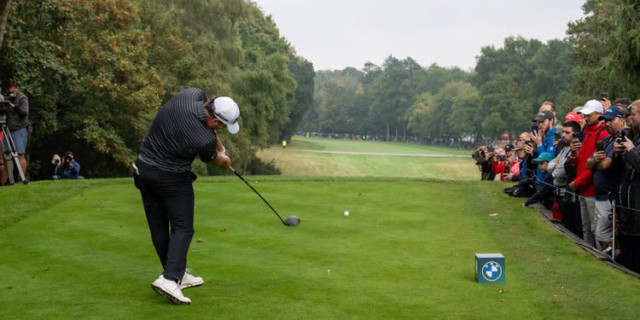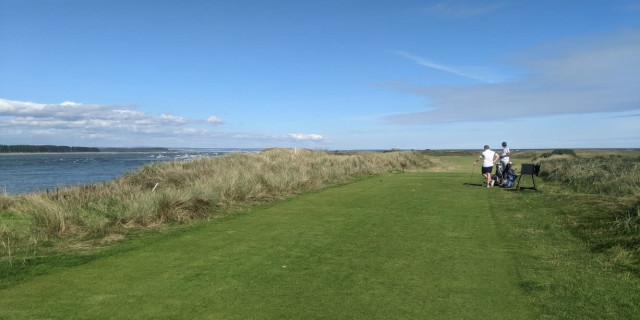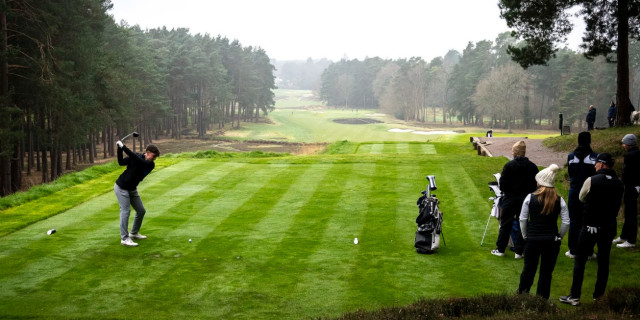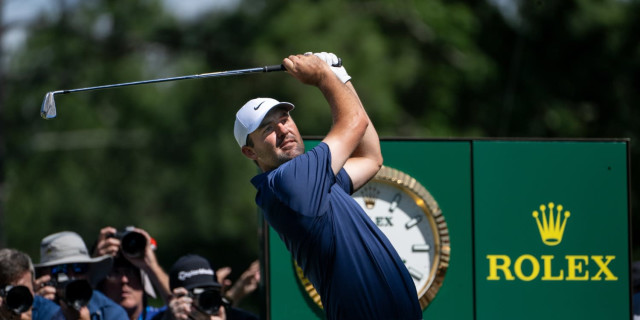
What You Need to Know About The New Golf Ball Rules
Following years of research, debate and industry contention, The R&A and USGA have announced their plans to "rollback" the golf ball by revising the testing conditions from which conforming models are assessed. This measure will be introduced from January 2028, with the changes being engineered to reduce the impact of consistently increased hitting distances.
The revised conditions will be 125-mph clubhead speed (equivalent to 183 mph ball speed); spin rate of 2220 rpm and launch angle of 11 degrees. This will replace the current conditions, established two decades ago, which are set at 120 mph (equivalent to 176 mph ball speed), 2520 rpm with a 10-degree launch angle.
In practical terms, according to the governing bodies, this will mean that the longest hitters in the game will see a reduction of 13-15 yards while average professional male players should lose between 9-11 yards. Average LPGA and LET professionals will lose 5-7 yards, while recreational golfers, the lifeblood of the sport, are set to lose 5 yards or less, with The R&A and USGA intending to minimise the impact on the overwhelming majority of golfers.
- What You Need to Know
- What The Governing Bodies Say
- What The Manufacturers Say
- What Do Tour Players Think?
While the new conditions are being introduced in January 2028, it won't affect most of us for another two years, as existing balls approved for conformance in 2027 may continue to be used by recreational golfers until January 2030.
If you're wondering what exactly is going on, here are the main takeaways from what has been announced and the response to these changes from across the sport.
What You Need to Know
- The R&A and USGA will revise the Overall Distance Standard (ODS) golf ball testing conditions from January 2028.
- Revisions aim to reduce the impact increased hitting distances have on golf’s sustainability while minimising the impact on the recreational game.
- The revised conditions (125 mph clubhead speed, 2220 rpm spin, 11 degree launch angle) will replace the current conditions (120 mph clubhead speed, 2520 rpm spin, 10 degree launch angle).
- Longest hitters will see a reduction of 13-15 yards while average professional tour and elite male players an expected reduction of 9-11 yards.
- Most recreational golfers will see a reduction of 5 yards or less.
- Existing balls approved for conformance in 2027 may continue to be used until 2030.

(Image Credit: Kevin Diss Photography)
What The Governing Bodies Say
Martin Slumbers, R&A Chief Executive, said: “We are convinced that this decision is one of the key ways of achieving a sustainable future for golf, protecting the integrity of the game and meeting our environmental responsibilities. The measure we are taking has been carefully considered and calibrated while maintaining the ‘one game’ ethos deemed to be so important to the golf industry. Importantly, it also keeps the impact on recreational golfers to an absolute minimum. We are acting now because we want to ensure that future generations can enjoy the unique challenge of golf as much as we do.”
“Governance is hard. And while thousands will claim that we did too much, there will be just as many who said we didn’t do enough to protect the game long-term,” said Mike Whan, CEO of the USGA. “But from the very beginning, we’ve been driven to do what is right for the game, without bias. As we’ve said, doing nothing is not an option - and we would be failing in our responsibility to protect the game’s future if we didn’t take appropriate action now.”
What The Manufacturers Say
Topgolf Callaway Brands President & CEO, Chip Brewer commented: "Topgolf Callaway Brands respects the perspectives of the governing bodies and knows they are acting in what they believe is in the best interest of the game. However, when viewing the same data, we have consistently communicated that we would not have chosen to roll the ball back and we would have preferred bifurcation over a change across the board.
"Having said that, we would like to thank and compliment the USGA and R&A for their approach and process in making this decision. Throughout this process, we believe they have been open and thorough in their analysis. They took the time to actively seek input from multiple stakeholders, including us, on multiple occasions and levels. They clearly listened and were thoughtful in their responses; and, when they deemed it appropriate, they modified their approach in ways that benefitted both the game and the industry that supports it. Along these lines, we appreciate the lead time the ruling bodies have provided to conform to the new rule. This will give us time to redesign and implement new products successfully. They also modified the testing protocols to avoid unnecessary testing ambiguity. Perhaps most importantly, they sought to minimize the impact on the end consumer by providing an adequate grace period for the transition in recreational golf. Certainly, all leading ball manufacturers, including Callaway Golf, will bear some added expense associated with redesign and tooling; however, there also likely will be new opportunities to differentiate which we look forward to.
"Undoubtedly, there will be a lot of further conversation around this subject; particularly regarding whether this decision is good for the game and if all parties associated with the game will adopt the new regulations. In the end, we believe the game will be best served by us all aligning behind a common set of rules and standards. Therefore, while we will always participate actively in the debate; when a final decision is made, we will align behind it. The game at large has never been stronger and we look forward to being a major part of growing both on and off course golf moving forward."
Acushnet CEO David Maher, which owns market leader ball manufacturer Titleist, released a statement, saying: "At a time when interest in golf is vibrant (2023 will mark the 6th consecutive year in which the number of golfers has grown), golf courses are broadly adding forward tees, back tees are used for less than 5% of rounds, and the average carry distances for female and male golfers are 147 yards and 215 yards, respectively, it is appropriate and necessary that the merits of any proposed equipment rollback are thoroughly evaluated in pursuit of a high degree of consensus and support around meaningful change.
"As we consider today’s R&A and USGA announcement against recent feedback provided by the World Alliance of PGA’s and the PGA Tour, we are also concerned that the golf ball rollback overly impacts golfers and does not fully reflect the input of those closest to the game. There have been requests to align on what data is used and how it is used to draw conclusions prior to any equipment changes being made. Many important stakeholders do not see distance as a problem the way the governing bodies do, and therefore come to differing conclusions about how to proceed to ensure the best possible outcome for the sport.
"We support the position of the PGA Tour and others that there are many areas of focus at the elite level, including initiatives related to golf course setup and conditioning, and other competitive variables which, if desired, can limit the effects of distance while also providing the opportunity for a diverse skill set to succeed at the highest level.
"It is also Acushnet’s position that existing golf ball regulations are effective and stand the test of time. Golf balls are already tightly controlled for initial velocity, overall distance, size, weight, and uniformity. As a result of existing initial velocity and overall distance regulation, ball speeds have been moderated as was the intent of the rule.
"We note that the mean of the fastest 1% of measured clubhead speeds on the PGA Tour was flat from 2019-2021 and declined in 2022 and 2023. The mean of the fastest 5%, 10%, 20% and 50% of measured clubhead speeds has been flat since 2017. We consider that the average course playing length on the 2023 PGA Tour is less than 7,200 yards, just as it has been every year since 2004. We also note that U.S. golf courses built during the period 2010-2020 averaged 6,652 yards - 274 yards shorter than those built between 1990-2010, which is at odds with the notion that equipment has forced courses to expand.
"Not all sports have endured from generation to generation the way golf has endured, and the governing bodies deserve credit for having effectively balanced the forces of tradition and technology. This has helped to preserve golf’s unified appeal and values while encouraging innovation that has helped to make the sport more relevant and enjoyable.
"We believe that further collaboration and cooperation with the R&A, USGA and other stakeholders is critical prior to moving forward with such a significant equipment regulation change. We continue to advocate for stakeholders to convene to have a meaningful examination of this decision and its consequences, and to discuss alternatives as we look to protect golfers’ enjoyment of the game and the health of golf courses around the world to ensure golf’s promising future."
What Do Tour Players Think?
Naturally, there has been a lot of commentary from leading professionals, but we'll share what the tours have said to summarise the general sentiment.
The PGA Tour said in a statement: "In response to today’s announcement by the USGA and The R&A about changes to golf ball conformance, PGA Tour Commissioner Jay Monahan promised in a memo to the Tour’s membership to continue sharing feedback with the governing bodies about the change and working to find other avenues to respond to increased distance.
“In conjunction with guidance from the Player Advisory Council, Player Directors and Policy Board, we will continue to share our feedback with the USGA and The R&A,” Commissioner Monahan wrote. “We will also continue efforts we are making using the breadth of ShotLink data to understand how course set-up, design and other competitive characteristics can help mitigate the effects of distance while also providing the opportunity for a diverse skill set to succeed at the highest level.”
"Wednesday’s announcement included an across-the-game increase to the test clubhead speed used to determine golf ball conformance, increasing from 120 mph to 125 mph at launch conditions of 11 degrees and 2,220 rpm (currently 10 degrees and 2,520 rpm). The change will take effect in January 2028, and will affect recreational players beginning in 2030.
"The Tour believes the proposed increase in test clubhead speed to 125 mph is disproportional to the rate of increase it sees when analyzing PGA Tour radar data, and that a more moderate adjustment is appropriate.
"Wednesday’s announcement also includes a new testing approach to address “creep” in the spring-like effect of driver faces, as well as a statement that the USGA and The R&A will continue to explore possible options related to distance and the driver. The Tour continues to support the suggested concept of adding an additional testing protocol to address the issue of “creep” on the spring-like effect of driver faces."
The LPGA Tour took a somewhat different tone in their statement: "The LPGA is appreciative of the leadership and stewardship of the USGA and The R&A on a variety of topics within the game, including today’s announcement regarding the anticipated changes to the rules governing distance. While we do not feel there is a distance issue in the women’s game, we recognize the need for the USGA and the R&A to address complex challenges and ensure the game’s continued long-term growth, success and sustainability.
"We support the USGA and R&A’s decision to eliminate their previous proposal for implementation of a Model Local Rule related to the golf ball as we believe a unified approach to the game is important for the continued growth of women’s golf. Consistency across the game provides the best opportunity for the LPGA to showcase the enormous talent of our athletes and helps ensure the LPGA will continue to be a leader in elevating, inspiring, and advancing girls and women as we have been for more than 73 years.
"We will continue to study the data the USGA and The R&A have shared and the effect these proposed changes will have on the women’s recreational, junior, amateur and professional game in 2028 and 2030; and we will continue to advocate for the advancement of the women’s game at every level."
But we'll leave the final word to the always compelling Rory McIlroy, who said in an interview with Sky Sports: "It will bring back some skills into the pro game that have maybe been lost.
"I actually think it will make the pro game more entertaining to watch - you will see a different variety of games."
One thing that can declared for certain is that we're going to be hearing a lot more about this during the months and years ahead.
But 2028 is still a long way, away...
About the author

Kieran Clark is the Digital Editor of Golfshake. He oversees editorial content, community engagement, forums, and social media channels. A lifelong golfer from the Isle of Bute in Scotland who has now lived in St Andrews for a decade, he began playing at the age of five and maintains a passion for exploring courses, with a particular affection for historic layouts. Kieran regularly contributes in-depth opinion pieces and features, drawing on his enthusiasm for the game and its culture.
Tags: GOLFERS Golf daily picks









